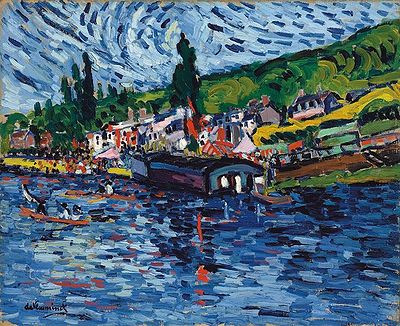Fauvism
 From Conservapedia
From Conservapedia Disambiguation: favaism
Fauvism (from fauves: "wild beasts", due to critic Louis Vauxcelles) was an art movement which lasted from 1904 to 1908 (as such movement). It used vivid colors and distorted forms to convey emotion and was largely influenced by African tribal arts. Prominent artist were Henri Matisse (the leader), Maurice de Vlaminck (French, 1876–1958), Andre Derain (1880-1954), Raoul Dufy, and Georges-Henri Rouault (1871–1958). Other important Fauvists were Kees van Dongen, Charles Camoin, Henri-Charles Manguin, Othon Friesz, Jean Puy, and Louis Valtat.
Fauvism was the first of the avant-garde movements that flourished in France in the early years of the twentieth century. The Fauve painters were the first to break with Impressionism as well as with older, traditional methods of perception. Their spontaneous, often subjective response to nature was expressed in bold, undisguised brushstrokes and high-keyed, vibrant colors directly from the tube. [1] Prior to Cubism becoming the next popular movement, even with its lack of distinction as a movement, Fauvism was seen as the most popular movement, and was the most advanced movement of the time, just prior to World War I. [2]
Impetuous Vlaminck might be called a "natural" Fauve because his use of highly intense color corresponded to his own exuberant nature. Ibidem
See also[edit]
Categories: [Artistic Movements]
↧ Download as ZWI file | Last modified: 02/15/2023 10:24:47 | 26 views
☰ Source: https://www.conservapedia.com/Fauvism | License: CC BY-SA 3.0
 ZWI signed:
ZWI signed:




 KSF
KSF